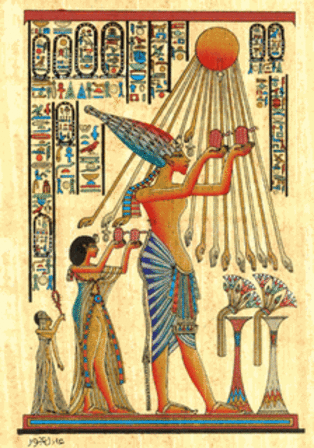The Egyptian Book of the Dead demonstrates that the Egyptian people originally believed in one great God and not many.

Maspero admitted that the Egyptians applied the epithets, “one God” and “only God” to several gods, even when the god was associated with a goddess and a son, but he adds “ce dieu Un n’etait jamais DIEU tout court”; the “only god” is the only god Amen, or the only god Ptah, or the only god Osiris, that is to say, a being determinate possessing a personality, name, attributes, apparel, members, a family, a man infinitely more perfect than men.
Egypt Monotheism
Akhenaten showed no interest in promulgating his faith — not until it became to his political advantage to do so. Akhenaten raised Aten to the position of a sole god, bringing monotheism to Egypt. He and his family are frequently shown worshiping Aten by reaching out to him.
The time leading up to Akhenaten showed “a progressive increase” in the regard for the sun god and a view of Re as a universal god. The 18th dynasty saw a rise of “Heliopolitan” cults and a “solarization” of the principal gods of Egypt.
Akhenaten’s Egypt Monotheism, in line with this view, was neither evangelical nor exclusive.
definition of Ra
The Ancient Egyptian definition of Ra is the perfect representation of the Unity that comprises the putting together of the many diverse entities, i.e. The One Who is the All. The Litany of Ra describes the aspects of the creative principle: being recognized as the neuter (gods) whose actions and interactions, in turn, created the universe.
Certain animals were chosen as symbols for that particular aspect of divinity. When a total animal is depicted in Ancient Egypt, it represents a particular function/attribute in its purest form. When an animal-headed figure is depicted, it conveys that particular function/attribute in the human being.